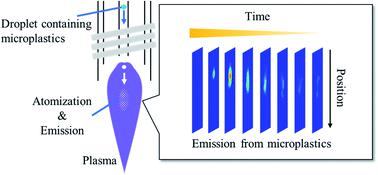当前位置:
X-MOL 学术
›
J. Anal. At. Spectrom.
›
论文详情
Our official English website, www.x-mol.net, welcomes your
feedback! (Note: you will need to create a separate account there.)
Size distribution measurement of microplastics using a temporally and spatially resolved inductively coupled plasma optical emission spectrometer (ICP-OES)
Journal of Analytical Atomic Spectrometry ( IF 3.1 ) Pub Date : 2021-07-22 , DOI: 10.1039/d1ja00114k Yoshiyuki Teramoto 1, 2, 3, 4 , Hyun-Ha Kim 1, 2, 3, 4
Journal of Analytical Atomic Spectrometry ( IF 3.1 ) Pub Date : 2021-07-22 , DOI: 10.1039/d1ja00114k Yoshiyuki Teramoto 1, 2, 3, 4 , Hyun-Ha Kim 1, 2, 3, 4
Affiliation

|
We studied polystyrene microspheres of 1.5 and 3 μm (substitute for microplastics) in water using an inductively coupled plasma optical emission spectrometer (ICP-OES). The samples were introduced as single monodisperse microdroplets at a high frequency. To increase the stability of sample introduction over that in the conventional method, microdroplets were dispensed in the direction of gravity by inverting the ICP torch. The atomization process of polystyrene microspheres in droplets was observed using a high-speed camera equipped with a double monochromator. The serial photographs of the emission process showed that the temporal characteristics of particle atomization were significantly dependent on the particle size. This suggests that the particle size can be estimated from the temporal characteristics of particle atomization depending on the particle size and emission intensity. Even at a high frequency (400 Hz) of sample introduction, the two peaks of 1.5 and 3 μm polystyrene microspheres could be distinguished in the particle size distribution measurements. Additionally, the estimated coefficient of variation (CV) of the 3 μm polystyrene microspheres was reasonable. Our study shows that the use of the temporally and spatially resolved ICP-OES with inverted-type torch is a powerful technique for estimating the size distribution of microplastics in water.
中文翻译:

使用时间和空间分辨的电感耦合等离子体发射光谱仪 (ICP-OES) 测量微塑料的尺寸分布
我们使用电感耦合等离子体发射光谱仪 (ICP-OES) 研究了水中 1.5 和 3 μm 的聚苯乙烯微球(微塑料的替代品)。以高频率将样品作为单个单分散微滴引入。与传统方法相比,为了增加样品引入的稳定性,通过反转 ICP 炬管沿重力方向分配微滴。使用配备双单色仪的高速相机观察液滴中聚苯乙烯微球的雾化过程。发射过程的系列照片表明,粒子雾化的时间特性显着依赖于粒子大小。这表明可以根据粒子大小和发射强度从粒子雾化的时间特征估计粒子大小。即使在样品引入的高频 (400 Hz) 下,1.5 和 3 μm 聚苯乙烯微球的两个峰也可以在粒度分布测量中区分出来。此外,3 μm 聚苯乙烯微球的估计变异系数 (CV) 是合理的。我们的研究表明,使用带有倒置炬管的时间和空间分辨 ICP-OES 是一种估算水中微塑料尺寸分布的强大技术。在粒度分布测量中可以区分 5 和 3 微米的聚苯乙烯微球。此外,3 μm 聚苯乙烯微球的估计变异系数 (CV) 是合理的。我们的研究表明,使用带有倒置炬管的时间和空间分辨 ICP-OES 是一种估算水中微塑料尺寸分布的强大技术。在粒度分布测量中可以区分 5 和 3 微米的聚苯乙烯微球。此外,3 μm 聚苯乙烯微球的估计变异系数 (CV) 是合理的。我们的研究表明,使用带有倒置炬管的时间和空间分辨 ICP-OES 是一种估算水中微塑料尺寸分布的强大技术。
更新日期:2021-07-22
中文翻译:

使用时间和空间分辨的电感耦合等离子体发射光谱仪 (ICP-OES) 测量微塑料的尺寸分布
我们使用电感耦合等离子体发射光谱仪 (ICP-OES) 研究了水中 1.5 和 3 μm 的聚苯乙烯微球(微塑料的替代品)。以高频率将样品作为单个单分散微滴引入。与传统方法相比,为了增加样品引入的稳定性,通过反转 ICP 炬管沿重力方向分配微滴。使用配备双单色仪的高速相机观察液滴中聚苯乙烯微球的雾化过程。发射过程的系列照片表明,粒子雾化的时间特性显着依赖于粒子大小。这表明可以根据粒子大小和发射强度从粒子雾化的时间特征估计粒子大小。即使在样品引入的高频 (400 Hz) 下,1.5 和 3 μm 聚苯乙烯微球的两个峰也可以在粒度分布测量中区分出来。此外,3 μm 聚苯乙烯微球的估计变异系数 (CV) 是合理的。我们的研究表明,使用带有倒置炬管的时间和空间分辨 ICP-OES 是一种估算水中微塑料尺寸分布的强大技术。在粒度分布测量中可以区分 5 和 3 微米的聚苯乙烯微球。此外,3 μm 聚苯乙烯微球的估计变异系数 (CV) 是合理的。我们的研究表明,使用带有倒置炬管的时间和空间分辨 ICP-OES 是一种估算水中微塑料尺寸分布的强大技术。在粒度分布测量中可以区分 5 和 3 微米的聚苯乙烯微球。此外,3 μm 聚苯乙烯微球的估计变异系数 (CV) 是合理的。我们的研究表明,使用带有倒置炬管的时间和空间分辨 ICP-OES 是一种估算水中微塑料尺寸分布的强大技术。











































 京公网安备 11010802027423号
京公网安备 11010802027423号